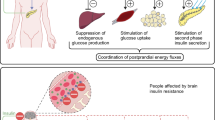Summary
Impairment of cognitive function is characteristic of untreated phenylketonuria in humans and in the pah enu2 mouse model of phenylketonuria. We measured regional cerebral metabolic rate for glucose in the adult male pah enu2 mouse to determine the effect of PKU on functional activity in brain and to discern what, if any, brain areas are affected. Our results demonstrate selective decreases (17–21%) in regions thought to be involved in executive function. Regions most significantly affected include prelimbic, anterior cingulate, orbital frontal and perirhinal cortex. Sensory and motor areas of cortex and hippocampus were remarkably unaffected.
Similar content being viewed by others
Abbreviations
- DG:
-
deoxyglucose
- HMZ:
-
homozygous
- HTZ:
-
heterozygous
- i.v.:
-
intravenous
- PKU:
-
phenylketonuria
- rCMRglc :
-
regional cerebral metabolic rate for glucose
- WT:
-
wild-type
References
Bauman ML, Kemper ThL (1982) Morphologic and histoanatomic observations of the brain in untreated human phenylketonuria. Acta Neuropath (Berl) 85: 55–63.
Bayliss BL, Gaffan D (1991) Amygdalectomy and ventromedial prefrontal ablation produce similar deficits in food choice and in simple object discrimination learning for an unseen reward. Exp Brain Res 86: 617–622.
Cabib S, Pascucci T, Ventura R, Romano V, Puglisi-Allegra S (2003) The behavioral profile of severe mental retardation in a genetic mouse model of phenylketonuria. Behav Genet 33: 301–310.
Chudasama Y, Robbins TW (2003) Dissociable contributions of the orbitofrontal and infralimbic cortex to Pavlovian autoshaping and discrimination reversal learning: Further evidence for the functional heterogeneity of the rodent frontal cortex. J Neurosci 23: 8771–8780.
Cohen NJ, Eichenbaum H (1994) Memory, Amnesia, and the Hippocampus. Cambridge, MA: MIT Press.
Dow-Edwards D, Crane A, Rosloff B, Kennedy C, Sokoloff L (1986) Local cerebral glucose utilization in the adult cretinous rat. Brain Res 373: 139–145.
Friedman HR, Goldman-Rakic PS (1994) Coactivation of prefrontal cortex and inferior parietal cortex in working memory tasks revealed by 2DG functional mapping in the rhesus monkey. J Neurosci 14: 2775–2788.
Gallagher M, McMahan RW, Schoenbaum G (1999) Orbitofrontal cortex and representation of incentive value in associative learning. J Neurosci 19: 6610–6614.
Goldman-Rakic PS (1995) Cellular basis of working memory. Neuron 14: 477–485.
Hasselbalch S, Knudsen GM, Toft PB, et al (1996) Cerebral glucose metabolism is decreased in white matter changes in patients with phenylketonuria. Pediatr Res 40: 21–24.
Jay TM, Jouvet M, DesRosiers MH (1985) Local cerebral glucose utilization in the free moving mouse: a comparison during two stages of the activity–rest cycle. Brain Res 342: 297–306.
Jones B, Mishkin M (1972) Limbic lesions and the problem of stimulus-reinforcement association. Exp Neurol 36: 362–377.
McDonald JD, Charlton CK (1997) Characterization of mutations at the phenylalanine hydroxylase locus. Genomics 39: 402–405.
Moore D (1994) Current Protocols Mol Biol 1: 2.1.1.
Otto T, Eichenbaum H (1992) Complimentary roles of the orbital prefrontal cortex and the perirhinal-entorhinal cortices in an odor-guided delayed-nonmatching-to-sample task. Behav Neurosci 106: 762–775.
Paxinos G, Franklin KBJ (2001) The Mouse Brain in Stereotaxic Coordinates. New York: Academic Press.
Puglisi-Allegra S, Cabib S, Pascucci T, Ventura R, Cali F, Romano V (2000) Dramatic brain aminergic deficit in a genetic mouse model of phenylketonuria. Neuroreport 11: 1361–1364.
Qin M, Kang J, Smith CB (2002) Increased rates of cerebral glucose metabolism in a mouse model of fragile X mental retardation. Proc Natl Acad Sci USA 99: 15758–15763.
Schulz B, Fendt M, Richardson R, Schnitzler H-U (2004) Temporary inactivation of perirhinal cortex by muscimol injections block acquisition and expression of fear-potentiated startle. Eur J Neurosci 19: 713–720.
Scriver CR, Kaufman S, Woo SLC (1989) The hyperphenylalaninemias. In: Scriver CR, Beaudet AL, Sly WS, Valle D, eds. The Metabolic Basis of Inherited Disease. New York: McGraw-Hill, 495–546.
Shapiro MB, Grady CL, Kumar A, et al (1990) Regional cerebral glucose metabolism is normal in young adults with Down syndrome. J Cerebr Blood Flow Metab 10: 199–206.
Shedlovsky A, McDonald JD, Symula D, Dove WF (1993) Mouse models of human phenylketonuria. Genetics 134: 1205–1210.
Smith CB, Kang J (2000) Cerebral protein synthesis in a genetic mouse model of phenylketonuria. Proc Natl Acad Sci USA 97: 11014–11019.
Sokoloff L (1989) Measurement of regional hemodynamic and metabolic changes in the central nervous system with imaging techniques. In: Battaini, F, ed. Regulatory Mechanisms of Neuron to Vessel Communication in the Brain. Berlin: Springer-Verlag, 345–392.
Sokoloff L (1996) Circulation in the central nervous system. In: Greger R, Windhorst U, eds. Comprehensive Human Physiology, vol. 1. Berlin: Springer-Verlag, 579–602.
Sokoloff L, Reivich M, Kennedy C, et al (1977) The [14C]deoxy-glucose method for the measurement of local cerebral glucose utilization: theory, procedure, and normal values in the conscious and anesthetized rat. J Neurochem 28: 897–916.
Turkheimer FE, Smith CB, Schmidt K (2001) Estimation of the number of ‘true’ null hypotheses in multivariate analysis of neuroimaging data. NeuroImage 13: 920–930.
Walton ME, Bannerman DM, Alterescu K, Rushworth MFS (2003) Functional specialization within medial frontal cortex of the anterior cingulated for evaluating effort-related decisions. J Neurosci 23: 6475–6479.
Wree A, Beck T, Bielenberg GW, Schleicher A, Zilles K (1989) Local cerebral glucose utilization in the autoimmune New Zealand Black (NZB) mouse. Histochemistry 92: 343–348.
Zagreda L, Goodman J, Druin DP, McDonald D, Diamond A (1999) Cognitive deficits in a genetic mouse model of the most common biochemical cause of human mental retardation. J Neurosci 19: 6175–6182.
Author information
Authors and Affiliations
Corresponding author
Additional information
Communicating editor: Michael Gibson
Competing interests: None declared
Rights and permissions
About this article
Cite this article
Qin, M., Beebe Smith, C. Regionally selective decreases in cerebral glucose metabolism in a mouse model of phenylketonuria. J Inherit Metab Dis 30, 318–325 (2007). https://doi.org/10.1007/s10545-007-0583-1
Received:
Revised:
Accepted:
Published:
Issue Date:
DOI: https://doi.org/10.1007/s10545-007-0583-1




